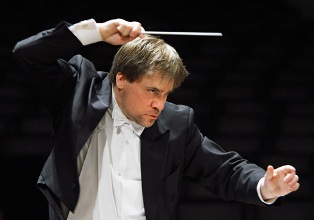
Storgårds' Sibelius Puts Him in the Running for the CSO
The Cincinnati
Symphony Orchestra intends to have a new music director on the podium of “revitalized”
Music Hall when the process of renovation is complete three years from now
(i.e. sometime in 2013).

That is the only timeline that can be put on the search for a successor to CSO music director Paavo Järvi, said Ann Santen, chair of the music director search committee, at a public forum held before Friday night’s CSO concert at Music Hall.
“However, we’re not going to take three years,” she added, and any guest conductor appearing with the CSO from now on -- an absolute pre-requisite for the job -- may be considered a candidate.
That includes guest conductor John Storgårds, who made his CSO debut on Friday’s concert. The Finnish born conductor may be more than “just a candidate,” judging by response to Sibelius’ Symphony No. 2, with which he concluded the program. The Sibelius Second is a thrilling work and Storgårds, 46, illumined its dark recesses in a thrilling way, earning a prolonged standing ovation and applause from everyone, including the CSO musicians.
It was a concert designed to please, also including Beethoven’s Concerto for Violin, Cello and Piano (Triple Concerto) and a seasonal opener, “Vesna” (“Spring”) by Russian composer Alexander Glazunov.
Soloists in the Concerto were violinist Baiba Skride, cellist Jan Vogler and pianist Lauma Skride.
Baiba and Lauma Skride are sisters and natives of Latvia. Vogler is German, a former orchestral musician now pursuing a solo career. The three gave a congenial performance of the Beethoven Concerto, which also marked a fine collaboration with Storgårds and the CSO.
Vogler, who had the most difficult part, often requiring extra-nimble playing in the cello’s highest register, had a few slippery moments. Otherwise, ensemble among the soloists was close, and each voice could be clearly heard. Baiba Skride, winner of the 2001 Queen Elizabeth of Belgium Competition projected a classically sweet tone, her sister Lauma a large one notable for its solidity and color. Vogler and the cello, which is frequently in the spotlight, kept much of the musical interest going. Response from the crowd, which included many young people, was warm.
Glazunov’s “Spring,” performed for only the second time in CSO history (the first was in 1917 led by music director Ernst Kunwald), made a diametric contrast to the Sibelius. Written when the composer was 26, it is full of airy sounds: glockenspiel, bird song by flutes and piccolo, and the gentle blend of flute and harp with orchestra. It was an utterly sweet vision of spring, with no thunderstorms or clouds on the horizon.
Sibelius offers a more exacting environment, one inspired by the forests, lakes and long winter nights of his native Finland. Storgårds, music director of the Helsinki Philharmonic, was in his element here, painting with broad, expansive gestures that gave dimension and richness to the CSO sound.
Something of a late comer to the podium, Storgårds is also a violinist, having begun his conducting studies at the age of 30 at the invitation of Finnish guru Jorma Panula at the Helsinki Academy. Storgårds was music director of Finland's Tampere Philharmonic from 2006-2009 and is also artistic director of the Chamber Orchestra of Lapland. He has a special affinity for contemporary and Finnish music, which he has recorded extensively.
Storgårds asked for a big romantic sound in the Sibelius and he got it (composed in 1901, the symphony derives strongly from 19th-century romantics such as Tchaikovsky). The CSO obliged him with obvious pleasure, from the undulating rhythms of the opening Allegretto to the heroic Finale.
The brooding Andante was particularly impressive. The shaping and timbre (color) of the double bass pizzicato at the beginning conjured a dark and desolate landscape, with the bassoons adding a lugubrious refrain. The strings, following the first big brass outburst, sounded weary and deeply introspective, and there were moments in the movement when one could almost feel lashing winds and the sting of cold.
The third movement, Vivacissimo, took off at a dizzying pace, all the better to feel it stop in its tracks (twice) and relish the most beautiful one-note melody ever written, sounded soulfully by principal oboist Dwight Parry and answered by principal cellist Ilya Finkelshteyn.
The symphony’s monumental Finale showed off everybody, the peerless CSO brasses and winds – one would have to travel far to hear their equal anywhere – and the lush CSO strings. The most stirring moments were not just the big, brassy ones, as in the concluding chorale, but the more ethereal ones where the orchestra parted in contrary motion, basses headed downward, violins upward, crowned at the top by principal flutist Randolph Bowman’s very sweetest exhalation.
Storgårds and the CSO delivered handsomely at the end. One felt that the summit had been reached (compliments to timpanist Patrick Schleker for his fine playing here and throughout the symphony). Storgårds seemed surprised -- graciously so -- when the orchestra awarded him a solo bow by refusing to stand at one point for the applause.
The concert repeats at 8 p.m. tonight at Music Hall. Tickets ($10-$95) at (513) 381-3300, the Music Hall box office and online at www.cincinnatisymphony.org